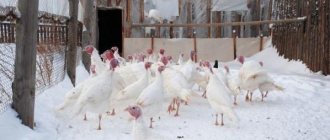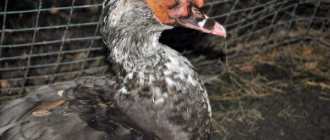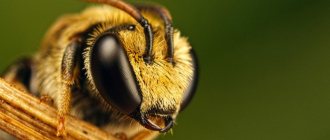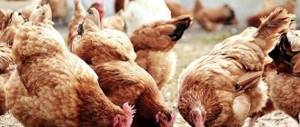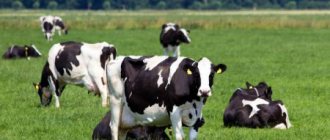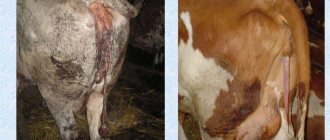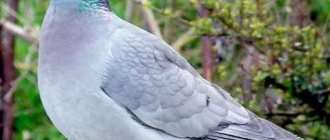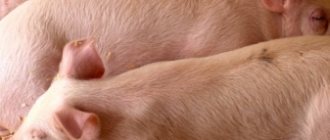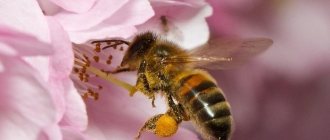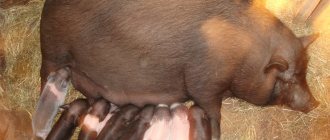How to put a goose on eggs
Before planting a goose, you need to make sure that the eggs laid are of high quality and fertilized. Considering that egg production begins in February, the diet of the breeding stock should be improved from the beginning of January. Introduce into your diet:
- more animal feed (whey, skim milk, meat and bone meal);
- steam the green leaves of clover and alfalfa hay (the best is selected and prepared for this period);
- add potassium permanganate (potassium permanganate) to the water. The deficiency of this element leads to low egg fertility. The solution is given slightly pink, 1 time per day.
When carrying out additional illumination, ensure the continuity of the process. Turn on the lights in the evening for 2-3 hours regularly. Abrupt cessation can stop egg laying and even cause molting. Daylight hours for breeding herds should be at least 14 hours.
Preparing for egg laying
To take care of a larger number of eggs laid, you should properly prepare the female for future egg laying. These procedures most often consist of several main stages.
Feeding
By the beginning of the spring season, the weight of the goose must increase by about 500-700 grams. To achieve such changes, it will be necessary to feed the bird more in the winter, increasing the volume of food it consumes. The frequency of administration should also be increased, otherwise proper results will not be achieved.
However, it is very important to take into account that fattening must be done carefully and carefully. Everything should be done gradually
Otherwise, the female may gain more excess weight, and obesity always negatively affects the level of egg production of geese. An individual suffers from excess weight if fatty deposits in the form of characteristic tubercles are noticeable under its wings.
It is also necessary to monitor the condition of the geese. They shouldn't be too greasy either. To do this, you need to change their diet starting in January. Habitual foods should be replaced with boiled or raw vegetables. It is acceptable to give pumpkin, cabbage, and carrots.
Room
It is not enough to fatten the birds correctly; you must prepare a suitable room for them. As a rule, geese need a comfortable house to lay eggs. In this situation, the owner needs to make sure that there are no drafts in the room where the goose will be. The optimal temperature in the poultry house is from 18 to 26 degrees.
Daylight hours should be at least 14 hours a day. It is necessary to ensure that the lighting is not too harsh or too dim. It should be calm, slightly muffled. Otherwise, the goose may experience serious stress, which will definitely not benefit egg production.
The floor of the poultry house should be covered with straw and sawdust. You will need to place trays there filled with sand mixed with ash. Such mixtures can be an excellent preventative against parasites, which are often found in the feathers of poultry.
It is also necessary to place nests in the house that are convenient for females. If you plan to place 3 females in the room, then it is not at all necessary to equip 3 separate nests for them. It will be enough to prepare one roomy nest in which all the birds will feel comfortable and where they will not be too crowded. In such conditions, females will not experience inconvenience or unnecessary worries.
Fencing
The poultry house must also be securely fenced off. This way you will protect the bird from negative external factors and from the penetration of various predatory animals. Only in such conditions can we talk about the safety and security of the birds, which continue to hatch eggs until the little goslings appear.
When the goose sits on eggs
Of all poultry, geese have the lowest reproductive index and a clearly defined seasonality.
oviposition.
The goose begins to lay eggs in February-March. Sometimes it lasts until June. All processes are very individual and depend on:
- breeds;
- feeding ration;
- length of daylight hours;
- age.
In most breeds, egg production increases with age. (The exception is the Kuban and Chinese breeds - their egg production decreases with age). Don’t expect to get large offspring from young geese, but 4-5 year olds will provide a high-quality hatch. This also applies to males. The gander has the ability to fertilize from the age of 9 months, but the quality of the sperm is low and the eggs remain empty. A 3-4 year old male will give you a very good percentage of goslings.
Average fertilization rate is 80-85%. This is due to the fact that the first eggs laid are usually empty. Spermatogenesis in males is delayed and does not keep pace with egg laying. At the same time, the landing of the gander does not indicate that the sperm is full and the egg will be fertilized. That is why it is recommended to keep 25% males in the herd. This is of course economically expensive, but significantly increases the percentage of fertilized eggs.
Many people are interested in how to find out whether an egg is fertilized or not. There is no way to visually determine this. However, if you practice keeping one gander for every 3 geese, the fertilization rate reaches 95-100%.
A goose lays one egg per day. She may lay the next egg the next day, or maybe after 3-4 days. The goose lays eggs at different times. The next day, the time of laying is postponed (with daily egg production). If the frequency of oviposition is 1 in 4-5 days, then, as a rule, the egg is “released” in the morning.
It is not possible to force a goose to sit on eggs before egg laying stops. But after finishing, there is no point in forcing her - she will sit down herself.
How many eggs can geese lay?
Compared to other types of poultry, geese have low egg production - an average of 30-50 eggs per year. These are large meat breeds: Kholmogory, Toulouse, large gray, Lindov, Danish Legard.
With proper maintenance, average breeds of geese bring up to 80-90 birds per year: Gorky, Hungarian white. Kuban and Chinese geese are capable of laying up to 100 eggs.
Peak egg production in all breeds of geese occurs in 2-4 years of the bird’s life. Read more in the article “How many eggs do geese lay?”
How many eggs does a goose lay?
The goose lays eggs in cycles. To determine how often a particular individual lays eggs, you need to monitor it. If the geese are different colors, then this is easy. If not, then they are marked, for example, with green paint. It is not difficult to catch the female in the nest, and then they record. Having laid a certain number of eggs, the goose takes a break for 5-6 days (everyone is different), and then begins laying eggs again.
The goose lays 35-40 eggs per year (sometimes up to 60). Some sources indicate the figure 120. This is possible, but only if the goose resumes laying eggs after some time. The primary process can last for 3-4 months (sometimes up to 7-8). Everything is very individual. For example, the Kholmogory breed is not characterized by high egg production and will not give you more than 30 eggs. Lindovsky geese have an average egg production of 40-50 eggs. Toulouse - 30-40. The egg production of geese is not an indicator of productivity, and even when describing the breed, the numbers are very arbitrary. It all depends very much on feeding and maintenance.
To obtain eggs evenly, the flock is formed with birds of different ages:
- young animals should account for at least 10%;
- two-year-olds - 20-30%
- three-year-olds - 40-50%;
- four-year students - no more than 10%.
How many eggs to place under the hen is a matter for the owner. If the female is large, then she can easily heat 15 pieces . If the bird is not large, then 12-13 .
Hatching process
The hatching process is characterized by the following features:
- hens scoop up the entire masonry;
- birds periodically turn over eggs, moving those located on the edges to the center;
- During brooding, appetite decreases.
During hatching, it is recommended to immediately remove damaged eggs upon detection. This will help prevent the spread of infection. You should also spray the nest with water heated to 40 degrees from the 15th day, shortly before the goose returns.
See also
Description and characteristics of Hungarian geese, pros and cons of the breed and careRead
How long does a goose sit on eggs?
Hatches eggs as intended by nature. It is clear from the goose that she has finished laying eggs and is preparing to incubate. She:
- stays in the nest for a long time;
- after expulsion returns to the nest;
- if one of the relatives still lays claim to the nest, he zealously drives him away, in the fight for the eggs;
- if there are nests nearby, it tries to roll other people's eggs under itself.
To test the female’s confidence in her intentions, you can place a model (an egg polished from white brick). If the goose is “entire” and does not leave the egg, then you can add a full platform and remove the model. You can place no more than 15 eggs under a goose. Do this at night.
A good time to “plant” geese
The life cycle of a goose is closely related to nature. Their reproductive instinct largely depends on the time of year and occurs in the spring. At the end of March, the birds begin to molt and the females collect fallen feathers, putting them in the nest and preparing a place for incubation. The owner, when planning to hatch goslings, must carefully look at the birds, choosing suitable brood hens. Young females get nervous, mark time in one place, and sit on a nest with one egg.
How to choose a goose for hatching chicks
How to choose a goose for hatching chicks
How long does an Indian duck sit on eggs?
The bird that is assigned the role of a hen must be absolutely healthy and have a calm, kind disposition. An adult bird that already has experience in raising chicks is more suitable for hatching chicks. Such a goose behaves much more carefully and becomes a caring mother. If there are only pullets on the farm, then you should carefully observe the behavior of the birds:
- good hens lay eggs less often than others;
- The goose, having laid an egg, does not leave the laying site, but begins to make a nest, lining it with its down. Such birds are reluctant to leave the nest, preferring to spend most of their time in it;
- having settled down in a prepared place, she does not jump up when a person approaches, but begins to hiss and flap her wings, trying to pinch, protecting her clutch;
- Having noticed such behavior, you can lay the eggs collected in advance on the goose. It is important to ensure that the goose lays its first egg in the nest. Afterwards she will lay all her eggs in one place;
- occasionally, in the absence of the brooding instinct, the goose has the opportunity to use a hen as a brood hen, placing no more than 5 goose eggs under it.
Important! A noisy and restless goose will not make a good hen.
How to store goose eggs for hatching geese
If geese are accustomed to a nest, then a dummy egg is placed in it. Then it is left, and the laid eggs are taken away. Eggs need to be collected frequently. This is especially important in frosty weather. Hypothermia (even temporary) can negatively affect the hatchability of goslings.
Eggs are stored in a clean, dry box at a temperature of 14-16 ᵒC for no more than 15 days. Experienced poultry farmers claim that if the egg is of high quality and fertilized, then even when stored for 20 days, the offspring appear viable.
To increase the shelf life of eggs after 5 days of storage, warm them in an incubator for 4-5 hours. In this case, the storage period can be extended by another 10 days. Read all about proper incubation of goose eggs here.
The following eggs are selected for incubation by the hen:
- medium size (small and large are not suitable);
- clean minor blots are washed with a solution of potassium permanganate. Do not use concentrated solutions, brushes or caustic detergents. The shell is porous and breaking the protective film will immediately lead to damage to the egg;
- whole. This cannot be determined visually. Eggs must be cleared before incubation. By placing an egg on an ovoscope or a lamp or flashlight, you can clearly distinguish cracks and marbling. Both the first and second ones are not placed under the hen;
- aligned in shape. Lumps, belts and irregularities allow eggs to be rejected. You can put them under the goose as a last resort, but you don’t need to count on a high yield of offspring.
Do not think that all the eggs laid by a goose will be suitable for laying. However, if the indicator is 70%, then this is good.
How many days does a goose hatch - individually for each case. Experienced poultry farmers have evidence that goslings hatched on the 32nd day. In very hot weather, incubation goes faster, and by day 28 all eggs can turn into goslings.
From the beginning to the end
Hatching time
The natural hatching time for goose offspring coincides with the incubation time. After all, in incubators the environment is as close as possible to the natural one. Read more in the article “About incubating goose eggs.”
On average, hatching lasts about 30 days for all breeds of geese. An error of 1-2 days in both directions is acceptable.
When all eggs are heated evenly, the clutch hatches within one day. For large specimens, the time period increases by several hours, since additional time is required for the full maturation of a larger mass. This explains why the chicks emerge at different times rather than simultaneously.
24 hours before hatching, the goslings can be heard scratching from the inside, pecking at the shell. You will find more information in the article “How long does a goose sit on eggs.”
Ovoscopy and emergence of chicks
Before hatching, farmers advise checking the eggs with an ovoscope. The presence of a clear vascular pattern and an air sac in the egg is necessary. Unfertilized specimens must be removed.
When the chicks hatch, the geese become nervous. The chicks are allowed to dry out and warm up - they sit under the goose for another day. Completely dried chicks are transferred to a basket or dry box covered with straw. How to properly build a house for young animals, read the article “Building a brooder for goslings with your own hands.”
If the chick cannot hatch for more than 2 days, it is removed using warm water, which is sprinkled on the egg. You can carefully pick out the peck site with tweezers disinfected in alcohol.
It is important to ensure that the goose accepts offspring after returning.
DIY goose nest
To build a nest you can use:
In any case they should be:
- spacious;
- clean;
- comfortable;
- Allow the bird to freely enter and leave the nest.
The size of the nest is selected for a specific individual. The hen does not sit still in the nest. She “takes care” of the eggs, turns them over, changes places. Movement should not be constrained. A nest 85x70 may well satisfy the requirements of a hen. The height of the nest should not be lower than 80 cm. If the nest is not liked, the goose may leave it and the offspring will disappear.
The nest is equipped in a place where:
- dry (despite the fact that the goose is a waterfowl);
- secluded;
- slightly dim light (complete darkness is not suitable).
The goose should have free access to food and water. If the bird does not get up on its own, then it is removed from the nest for feeding and emptying the intestines. She enters the nest herself. A female walk for 20 minutes is considered normal. When the goose is not in the nest, inspect the eggs. If there is a broken one, remove it.
Pay attention to the food. They must be of high quality, nutritious, easily digestible, rich in vitamins and in abundance. Read this article on how to properly feed goslings at different ages. 90% of success depends on the completeness of the diet. Using simple rules and observing the bird, you can easily achieve good egg production and high hatchability of young animals under a brood goose.
Feeding and hygiene
Food and water should be given to the hens every day, installing equipment for this at the brooding site. Birds need to be fed with selected grain and its waste. Birds spend about 20-40 minutes eating and walking.
The hen should sometimes wash herself to remove dirt, grass, and straw from the fluff of the lower part. To do this, you need to install a bathhouse from a trough or an old boat.
Adviсe:
- If the hen does not return to hatch, she must be driven into the building and carefully (sometimes using little force) placed on the eggs.
- If, on the contrary, she does not leave her home, then she is carefully lifted and carried to the location of the reservoir and food.
Negative cases
Sometimes a bird that has been hatching eggs for 21 days suddenly breaks them, drinks the liquid and eats the formed embryo. Some experts believe that the bird’s body did not receive enough of some nutrient, and the hen makes up for the deficiency by resorting to such cruel measures.
When hatching, it is necessary to add milk, cottage cheese, yogurt, skim milk to the hens' food, mixing them with regular feed.
Features of egg production
It is believed that geese are the first birds to be domesticated by humans, and their eggs entered our diet back in the Neolithic era. For a long time, geese were unjustifiably forgotten by farmers, although their maintenance is no more difficult than chickens. Eggs are much more nutritious, rich in lutein, large - on average up to 200 grams. However, poultry farmers can say that a chicken lays eggs almost every day, but not many people know how often a goose lays eggs. And there is truth in this, since these large birds do not lay very many eggs, so their clutch is used exclusively for hatching chicks.
The period when domestic geese begin to lay eggs and the number of eggs depends on many factors. Let’s say right away that you shouldn’t expect a lot of eggs from geese, but it all depends on the breed and living conditions. If for some the norm may be 120 pieces per year, then for others - 20 pieces is already the maximum amount. The highest rates of egg production with proper feeding are shown by Kholmogory, Chinese and Toulouse geese.
When and how long do they lay?
It is important to note that on average, geese begin to lay eggs between six months and a year, but the beginning of laying is always associated with hormonal changes in the body. Unlike chickens, geese show restlessness during this period and may lose weight. Geese also have their advantages. For example, it is no secret that these birds are famous for their longevity (25 years or more), and the egg production of females, unlike chickens, only increases over the years. In females aged three years and older, the clutch is larger and the number of eggs increases by 20%. But at what age depends most on the breed.
Geese do not lay eggs all the time, but periodically, usually for two to three months with a break of one or two months. Usually this period covers the warm season, less often females can begin laying in the fall. In many ways, the time and periods of egg production are related to the ambient temperature and the balance of the diet. If there is a lack of vitamins or nutrients, the bird’s body stops or reduces egg laying.
Adviсe
The process of incubating chicks will be as successful as possible if poultry farmers adhere to simple but important rules:
- You can determine the approach of the brooding period by such a fact as molting. When a bird begins to molt, it uses the fallen feathers and down as material for arranging a nest. At this time, it is necessary to place dummies in the nest or leave laid eggs in it, otherwise the oviposition process can continue for a very long time;
- when choosing future parents, it is necessary to ensure that the drake and goose are not close relatives, otherwise this will have a bad effect on the fertility of the material;
- Eggs that will be used for hatching must be stored properly. Experts recommend collecting them when they are still warm. In this case, the egg is taken with two fingers, one of which is placed at the blunt end, and the other at the sharp end. Next, the eggs are transferred to a cool, dry place. Dirty specimens must be cleaned within two hours after demolition;
- During hatching, the bird should be provided with a complete, balanced diet and provided with constant access to fresh water, dry food, and mineral supplements. This will make it possible to prevent exhaustion of the body. Dry grain mixtures are considered the best food during incubation. Consumption of wet mash is undesirable as it can cause digestive system upset;
- during cold weather, it is recommended to install additional heat sources in the room where the hen is located;
- If the hen does not get up from the nest for more than two days, she must be forcibly removed and brought to the feeder with food.
By properly placing a goose on eggs, providing her with competent care, balanced nutrition and comfortable conditions, even inexperienced poultry farmers will be able to get healthy, high-quality offspring in a short time. Having studied all the nuances of this event, you can successfully raise geese, receiving from this not only a good profit in the form of delicious dietary meat, but also a lot of pleasure.
Hatching offspring
Geese are naturally excellent mothers and good hens. Usually they do not have to be forced into the nest, and egg-laying ends with a period of incubation. Before sitting on the clutch, the bird begins to molt, and the female covers the nest with the fallen down. A hen in preparation is easy to distinguish from other females: she rarely leaves the nest and carefully guards the clutch. Such a preparing mother can be seen in the video of the Just Me channel.
The number of eggs depends on the size of the female: larger birds can heat about 15 eggs, small ones - no more than 9-10.
The average incubation period for brood geese is 30 days. Exactly how long they sit depends on the specific case, but fluctuations rarely exceed 1-2 days.
In order for the incubation process to be successful, it is important to create the right conditions. At this time, the hen should be protected from her relatives, and the nest should be placed in a dark, warm, well-ventilated place. There should always be a feeding trough and a drinking bowl near the hen, and from the 15th day it is also necessary to set up a swimming pool - an artificial small pond. If there are several hens, they need to be separated, preferably so that they do not intersect. It is not uncommon for females to confuse nests and both sit on the same clutch. Also, older and stronger females take eggs from the pullets and drive them away from the clutch.
We choose a hen goose to hatch eggs.
Geese are good hens, but from my own experience I will say that the best hens are geese aged 2 years or more, young one-year-olds are not so responsible, they can leave the nest for a long time, they can sit for a couple of days and abandon it altogether, so you need to keep an eye on them, If the hen gets up from the nest and walks for more than half an hour, she needs to be driven back into the nest.
How to determine that a goose is no longer laying eggs, but has sat down to hatch them? Let's watch an interesting video: the goose's reaction to the author of the video.
The hen does not get up from the nest, she sits in it day and night; if you get close to the nest, the hen begins to hiss aggressively. These are sure signs that the brooding process has begun and eggs need to be placed under the hen.
Now I’ll answer another important question - how many eggs should I put under the goose?
Exactly as much as the goose can completely cover them in her nest.
From my own experience, I will say that it depends on the size of the goose itself, there are large breeds, there are smaller ones, a large goose can cover about 15 eggs, smaller geese can cover 11 - 13 eggs. But on average, focus on 13 - 15 pieces, this is the optimal number of eggs that can be placed under the hen goose.
You need to lay the eggs in the evening, when it is already dark, so that the hen is not too worried, this must be done carefully, preferably together, one lifts the goose, and the second places the eggs in the nest.
The nest with the goose needs to be fenced off a little with a curtain or a piece of plywood, a secluded corner should be made so that other geese do not see the nest, do not disturb the hen, do not sit in her nest to lay eggs and do not drive her out of the nest.
Provide the hen with access to water and food; the water should be in a wide container so that the goose can bathe in it; after bathing, she sits on the eggs in the nest with wet fluff and wets the shells
This is very important, the shell of goose eggs is very hard, and in order for the chicks to peck at it, the shell must be moistened with water
You need to keep an eye on the hen, make sure that she periodically gets up from the nest to drink water and eat; if the hen does not get up from the nest for several days in a row, she needs to be driven away and brought to the feeder. While the hen is walking, you can check the condition of the eggs.
The goose plucks a lot of down from herself and lines her nest with it, the down has high thermal insulation properties and retains heat well, when the hen gets up from the nest to eat, she covers the eggs with down and they remain warm.
A” here is a video where the goose has already hatched her goslings.
Depending on the characteristics of the breed, geese lay eggs at 6-9 months or at the beginning of the second year of life. It depends on the content - with comfortable conditions and good nutrition, this process can begin as early as 5-6 months. The weight of the bird also affects egg production.
How to plant on eggs?
If the geese do not show the brooding instinct, the farmer has a logical question of how to place the female on the clutch. Fortunately, this is not at all difficult to do. Before you force the eggs to hatch, you need to properly equip the nest site. The room temperature should be about 12-18 degrees. The nest should be placed in a secluded place away from other birds.
It is best to place the bird in the nest between the end of March and the beginning of April, so that the goslings appear in the warm season. The size of the nest should be approximately 85 by 65 cm, with a height of about 80 cm.
To stimulate the brooding instinct, several methods are used:
- You should always leave at least five eggs in the nest. To prevent products from spoiling during the period of identifying the hen, it is advisable to replace them with dummies. After the bird begins to lay the nest and pave the masonry, you can cover the dummies with hatching eggs. It is impossible to say exactly how long this preparation process will take.
- Starting in January, you can plant the goose in the nest in the evening and cover it with a specially made box. However, this method is less common as it does not always give a positive result.
A good hen immediately begins to place eggs under herself, and after they are completely warmed up, she turns them from side to side. If the female does not leave the nest during the day, and her walks do not exceed 20 minutes, we can safely call her a hen. Upon completion of incubation, the geese become restless and often make bubbling sounds, stimulating the chicks to peck. After the goslings hatch, they do not need to be taken away from the hen until they are completely dry.
How many days do geese hatch eggs?
Geese are late-maturing birds. Females begin to produce eggs at 8-9 months of age. How many days a goose sits on eggs depends on their size and quantity. The incubation period for goose eggs is 28 days. In reality, this period increases to 30-32 days. In order for the goslings to be born into a friendly brood, the eggs in the nest should be regularly turned over and rearranged. This will ensure their uniform heating on all sides.
For your information! Goslings are able to swim a few hours after hatching, so you need to think in advance about a pond or a large vessel with water.
How long does a goose sit on eggs and why doesn't she do it?
Humanity domesticated geese 3-4 thousand years ago and since then the birds have proven their benefits many times. They once saved Rome by waking up the sleeping guards when the Gauls were about to sneak inside. Nowadays, geese are usually bred for their eggs, meat and feathers. The business turns out to be very successful, but only on the condition that the breeders know all the nuances, and breeding geese is different from raising chickens and ducks. For example, if a businessman did not find out in advance how long the goose has been sitting on eggs, he will probably face disappointment and losses.
How many days do geese hatch eggs?
Planting methods
Not only novice poultry farmers, but also very experienced ones may encounter a problem when geese do not want to sit on eggs. Many farmers place dummy eggs in nests to stimulate active incubation.
But sometimes even competent stimulation cannot force the bird to hatch its chicks. In such cases, two landing methods are used: voluntary and forced.
The voluntary method is to create ideal conditions for a potential hen, which include:
- moving the nest to a separate room;
- maintaining a comfortable temperature regime of at least +12 degrees and optimal air humidity of 60–75%;
- creating a quiet, dimly lit environment;
- removal of any foreign odors and noises.
Under natural conditions, geese hatch their offspring near water sources: reservoirs, ponds, lakes. Therefore, you can place a basin of water near the hen or dig a small hole.
Voluntary
By recreating such conditions and leaving the goose in the house where she lay, you can ensure that she herself begins the process of hatching. But if even under such circumstances this did not happen, then the bird can be forced to sit on the eggs.
Video: How to understand that a goose is preparing to sit on the nest
Forced
Experienced poultry farmers, before the start of the intended egg laying, place the bird in a separate nest and cover it in such a way that it cannot escape. A wooden basket, paper box, etc. is used for shelter. It takes 3-4 days for a goose’s instinct to activate. At the same time, dim lighting is left in the room during the day, and the lights are completely turned off at night. If after a few days the bird remains in the nest and makes no attempt to escape from it when the box is removed, then it can be safely used to hatch goslings.
The difference between a goose and other birds
The body size of birds is usually large, and goose eggs are also rather large. The legs, like the neck, are very high, and the beak is wide, strong and sharp. Seeing, in their opinion, an intruder, the geese mutter ominously or hiss irritably.
In the summer, raising birds is both pleasant and economical, since at this time of year they can find food for themselves in the nearest meadow or in a grassy yard.
It is worth considering that the dimensions, character, and color of feathers depend on the breed, and there are many breeds of domestic geese. Since the eggs are large, geese lay a small number of eggs per laying, but this also depends on the breed. It would be correct to decide from the very beginning why exactly the decision was made to breed these birds and choose a breed based on the results of the deliberations. On the video on the Internet you can watch and compare meat geese and those raised for eggs.
The relevance of breeding geese for eggs
How relevant it is to breed geese for eggs is a big question.
- Geese were domesticated 3 or 4 thousand years ago and since then their eggs have become part of the human diet. They are larger than chicken and much more nutritious, although the taste may seem strange to some gourmets.
- The yolks contain lutene, an extremely valuable substance with antioxidant properties. Regular consumption of goose eggs rejuvenates the body and slows down aging.
- On the other hand, there is also harm. Firstly, all breeds of geese are unclean, and their eggs cannot be enjoyed raw; long-term processing is required. Secondly, eating more than a few eggs a day is unhealthy.
- Size and rarity affect the price. Goose eggs are expensive, but birds bring only a small number of them per year. The most egg-laying breeds produce about 100 eggs per season, so it is difficult to consider breeding geese in this capacity as a profitable business.
Breeders usually use these birds as laying hens for the first 4-5 years, then sell them for meat.
Which eggs to lay
Of course, firstly, they must be fresh. For hens, specimens of regular oval shape are selected. They must have a clean and smooth surface, free of lime deposits. It should be added while the female is eating food.
A week after the hen sits on the eggs, they should be viewed against the light. If the embryo is in good condition, then a small dark spot with branching red threads is clearly visible. These are the blood vessels of the future gosling.
The air chamber in a healthy masonry should be located at the blunt end or be slightly offset to the side. The yolk is usually in the center, but may move a little closer to the chamber. The unfertilized clutch does not contain embryos. It is taken out of the nest and used for food.
If possible, then an ovoscope should be used for selection. By scanning, you can accurately determine the size and position of the air chamber, the condition of the yolk, the presence of foreign inclusions in the embryo, the degree of marbling of the shell and the presence of notches on it. The increase in the number of poultry on the farm ultimately depends on how many healthy embryos the hen hatches.
Video “Candling an egg from under a goose”
In the video, a man checks an incubated egg for the presence of an embryo.
How many eggs can a goose lay?
How many eggs a female will lay depends on various factors, ranging from the breed to the conditions in which the bird is kept. A goose at 6 months is already ready to create a nest, although her body is not yet fully developed. In the first year the clutch will be small, the peak of fertility occurs in the third year of the female’s life. On average, they produce from 40 to 100 eggs per year, but there are breeds that produce no more than 20 eggs.
The duration of incubation of oviposition is 2-3 months. The females rest for a while and then lay eggs again. At home, you can increase the number of clutches per year so that they lay in almost any month. To do this, you need to feed the birds food that is healthy for them and monitor the daylight hours. How many days a goose hatches eggs at home also depends on the conditions under which this occurs.
“The gosling is dear to the goose, his child is dear to the man,” but in some cases the females refuse to sit on the nest.
During winter, the reluctance of geese to sit down to hatch their offspring is doubly dangerous, since the goose eggs become hypothermic, despite the fact that there will already be quite a lot of empty eggs in the clutch.
Basic landing rules
Onset and age
Knowing how to properly place a goose on eggs, the poultry farmer will quickly provide the farmstead with chicks, and then with healthy meat and eggs.
Puberty of geese occurs at 8-9 months. At this point they lay and sit on the eggs.
The ability to reproduce in geese lasts up to 5-6 years. Maximum egg production appears at 3 years of age. It depends on the region of residence, keeping and caring for the bird, diet and breed.
And also age. Geese 3-4 years old begin laying earlier than pullets. Their eggs are large, with a whole shell, the number is greater than that of young geese.
Feed, but do not overfeed
The farmer must provide the goose with adequate nutrition and increase its weight by half a kilogram. But obesity should not be allowed. This reduces egg laying and egg fertilization.
Young females are fed more abundantly, as they lose more weight than older geese.
During the periods of laying and preparing for brooding, geese are not limited in food. Read more in the article “What to feed geese from the first days of life at home.”
Signs of imminent masonry
In almost all geese, the reproductive instinct does not appear until late winter - early spring.
The main signs appear when the geese begin to trample the females, and the geese lower their tails, collect straw and fluff for the future nest, and sometimes sit down at the laying site for a few minutes.
At this time, farmers begin to select suitable females for incubation from those that sit on the nests.
To breed geese, for 3-4 geese you need 1 adult male of 2-3 years of age.
Search for a hen
When choosing a hen, you should pay attention to the behavior of the geese.
A good hen is distinguished by several characteristics:
- when a person appears, the female remains in the nest;
- protecting the clutch, the hen hisses and raises her wings.
If the goose got scared and left the clutch, you should not put it on the testicles. Such a female may leave the nest.
It has been noticed that young geese often leave the nest due to a weak reproductive instinct. Their eggs are smaller and their chicks are weaker.
How to build a house for geese
Geese hatch eggs only when they feel safe, so to speak, at home. It happens that the time seems to have come, egg laying should begin, but it does not. Why the geese don’t lay eggs in this case is not an idle question, because the success of the entire breeding event depends on this. Do not despair ahead of time; the capriciousness of females can be easily dealt with. How to do it?
- First of all, make sure that the nest is in a safe place, away from doors and passages. If several females are sitting in the gosling coop at the same time, their nests need to be fenced off. The poultry house itself should be isolated from other species of living creatures, especially from rats, mice and curious birds of other species.
- You can make a nest with your own hands from almost anything; they are usually built from boxes. It happens that the expectant mother chooses her own future nest: it is important to trace what exactly she wants and use this item.
- It is important to ensure that the optimal temperature in the goose house and the length of daylight are maintained, with the help of which the problem of how to put a goose on eggs will be solved by itself.
How to stimulate egg production and make a goose lay eggs in the nest?
By the time the goose is ready to lay eggs, it is necessary to build a nest for it by placing a box filled with hay in the house. In order for the bird to understand that the nest is prepared specifically for it, it is necessary to put some goose feathers in it.
Since geese tend to hide the eggs they lay, it is very important to ensure that the first egg is laid not in some random place, but in the nest, since later, no matter how far they go from the house, they will return to it . This requirement especially applies to young geese.
In order to stimulate egg production, newly laid eggs should be removed from the nest (it is advisable to do this in the morning so that the clutch remains warm), leaving a plaster cast or only one egg in it.
If all the eggs laid by the goose are left in the nest, she will begin to incubate them ahead of schedule. The process of laying eggs will stop.
When to put a goose on eggs?
The optimal time to start hatching goslings is the end of March or the first days of April. It is at this moment that the yard becomes much warmer, and the intensity of egg laying by geese noticeably decreases.
Birds preparing to lay eggs begin molting. They actively use the fallen fluff to insulate their nest.
When deciding how many eggs should be placed under a hen, you need to proceed from its dimensions: large geese can hatch up to fifteen eggs, small ones - no more than ten.
Making females feel maternal feelings
In fact, the important question is not how to get a goose to hatch eggs, but why she doesn’t do it. Once the problem is identified, placing the bird on the clutch becomes a matter of technique. Brooding problems are most common in young females. It's not a matter of desire, but the fact that they don't know how to sit on the masonry.
- One possible solution is to force the females onto the nests and cover them with boxes. After some time, you can see them voluntarily sitting on their clutches. How to do this is easy to see in the video.
- When looking for reasons, you should once again consider the conditions of detention. A hen may refuse to hatch chicks because the coop is too dark, light, or cold.
- After the eggs are laid, they are collected. They can be stored in a box with straw at a temperature of no more than 20 and no less than 15°C. Females refuse to sit on eggs if they are first collected and then laid again. At least one egg or its dummy must remain in the nest. After several days of storage, the nest can again be filled with future goslings; all that remains is to wait for their appearance.
- During the incubation period, it is worth candling the eggs from time to time. A simple procedure will allow you to determine whether there is an embryo under the shell and how it feels. It happens that mold develops inside. The goose continues to sit on such eggs, pointlessly wasting her time on them and endangering the rest of the children.
Choosing a bird to hatch
A day or two before the end of egg production, the geese begin to create a soft pillow from their own down, plucking it and laying it out in the nest. The period for choosing real hens begins after all the eggs have been laid. At this time, the female always sits on them and moves away only to eat a little.
The selection of brood hens and their subsequent placement in the nest should be done scrupulously to be sure that the bird will not leave its habitat and leave. In order for the eggs to be laid faster, they are removed from under the goose, dim light is installed in the room, and relative silence and a calm environment are ensured.
Before laying eggs for incubation, the future hen should be carefully checked for several days. If during the laying period she does not leave the nest when the owner or another person approaches, but hisses, makes warning sounds and flaps her wings threateningly, then this goose has passed the hen test.
It is necessary to plant it on the nest in the evening. After spending the night on it, she will get used to it and will treat the new place calmly. Many owners prefer experienced birds. Such a goose can raise 20–25 chicks, but young mothers with more than 12 babies should not be trusted.
If the herd is small and only one individual is supposed to be placed on the nest, it is left in the same place where it lay. Moving a brood goose to another nest sometimes causes severe stress and anxiety, and this negatively affects the embryos during incubation.
When a normal goose lands on the nest, it immediately begins to take care of the eggs. She rolls them under herself and sits them calmly. After warming up the embryos, the goose changes their places - the central ones roll out, and the side ones bring inward.
Embryos must not be overheated during incubation or brooding. Therefore, their frequent rolling towards the center and vice versa allows for equal heat distribution and provides the best conditions for the normal development of babies.
